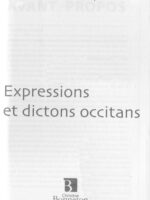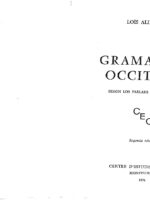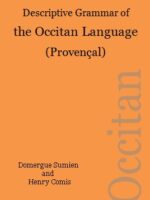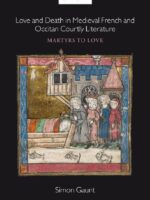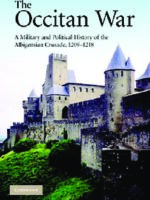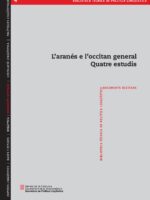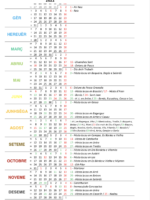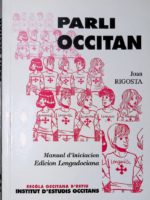Recommended Books
-
Expressions et dictons occitans
0,00 €De A autant d’argent que de pesolhs à Virar coma un baciu fagord, ce sont plus de 1000 expressions et dictons occitans, enracinés au plus profond de notre quotidien, qui sont réunis et expliqués dans cet ouvrage. A leur source, l’observation et l’imagination pour les unes : Aimable coma una mosca d’ase ; Aver d’argent coma un chin de nièras ; Aver un cuol coma un amolaire ; Cargat coma un muol; Curios coma un pet ; Dormir coma una missara. la musicalité et la rime qui facilitent la mémorisation pour les autres : Al mes d’abriu, Io cocut canta, mort o viu ; Auba roja, vent o ploja ; Cada topin troba sa cabucèla ; Es lo matin que la jornada se pèrd o se ganha ; Grèc, pluèja al bec ; La raça raceja. Tous ont été choisis par l’auteur à partir d’enquêtes et de lectures personnelles.
-
Descriptive Grammar of the Occitan Language (Provençal)
0,00 €Like Old French, from the 9th to the 13th century, Old Occitan preserved the two-case system of Vulgar Latin, subjective and objective, and it seems that until the middle of the 12th century, the written and spoken languages were identical. Then, the distinction between the cases disappeared in spoken usage, though they still persisted in the written texts of the Trobadors. This period can be qualified as the Golden Age or the time of the Trobadors.
A second period ranges from the beginning of the 14th century to the middle of the 16th. It is characterized by the dropping altogether of the flexions in witten texts, by the beginning of dialectization, the dropping of courteous vocabulary and the use of learned words borrowed from Latin and Greek to express law, medecine, philosophy and theology. Occitan was no longer a literary language, but it was used to write the deeds, the accounts, the chronicles and the resolutions of local communities. Since the second half of the 16th century to our days, Occitan was banned from written documents, and reduced to oral usage only, mainly by country and working people, in their everyday life, at work or at home.
-
Love and Death in Medieval French and Occitan Courtly Literature: Martyrs to Love
0,00 €Some of medieval culture’s most arresting images and stories inextricably associate love and death. Thus the troubadour Jaufre Rudel dies in the arms of the countess of Tripoli, having loved her from afar without ever having seen her. Or in Marie de France’s Chevrefoil, Tristan and Iseult’s fatal love is hauntingly symbolized by the fatally entwined honeysuckle and hazel. And who could forget the ethereal spectacle of the Damoisele of Escalot’s body carried to Camelot on a supernatural funerary boat with a letter on her breast explaining how her unrequited love for Lancelot killed her? Medieval literature is fascinated with the idea that love may be a fatal affliction. Indeed, it is frequently suggested that true love requires sacrifice, that you must be ready to die for, from, and in love. Love, in other words, is represented, sometimes explicitly, as a form of martyrdom, a notion that is repeatedly reinforced by courtly literature’s borrowing of religious vocabulary and imagery. The paradigm of the martyr to love has of course remained compelling in the early modern and modern period.
This book seeks to explore what is at stake in medieval literature’s preoccupation with love’s martyrdom. Informed by modern theoretical approaches, particularly Lacanian psychoanalysis and Jacques Derrida’s work on ethics, it offers new readings of a wide range of French and Occitan courtly texts from the twelfth and thirteenth centuries, and argues that a new secular ethics of desire emerges from courtly literature because of its fascination with death. This book also examines the interplay between lyric and romance in courtly literary culture and shows how courtly literature’s predilection for sacrificial desire imposes a repressive sex-gender system that may then be subverted by fictional women and queers who either fail to die on cue, or who die in troublesome and disruptive ways.
-
The Occitan War: A military and political history of the albigensian crusade (1209-1218)
0,00 €In 1209 Simon of Montfort led a war against the Cathars of Languedoc after Pope Innocent III preached a crusade condemning them as heretics. The suppression of heresy became a pretext for a vicious war that remains largely unstudied as a military conflict. Laurence Marvin here examines the Albigensian Crusade as military and political history rather than religious history, and traces these dimensions of the conflict through to Montfort’s death in 1218. He shows how Montfort experienced military success in spite of a hostile populace, impossible military targets, armies that dissolved every forty days, and a pope who often failed to support the crusade morally or financially. He also discusses the supposed brutality of the war, why the inhabitants were for so long unsuccessful at defending themselves against it, and its impact on Occitania. This original account will appeal to scholars of medieval France, the Crusades, and medieval military history.
LAURENCE W. MARVIN is Associate Professor of History at the Evans School of Humanities, Berry College, Georgia.
-
L’aranés e l’occitan general: Quatre estudis
0,00 €Er Estatut d’Autonomia hè oficiau era lengua occitana en Catalonha. Se concrète en Art 6.5.: Era lengua occitana, nomentada aranés en Aran, ei era lengua pròpria d’aguest territòri e ei oficiau en Catalonha, cossent damb çò qu’establissen aguest Estatut e es leis de normalizacion lingüistica. Ua des responsabilitat qu’a d’assumir era institucion, ei a dí- der era Generalitat e eth Conselh Generau d’Aran, en procès de metuda era practica dera oficialitat dera lengua occitana, ei era sua referéncia lingüistica. Ua lengua a de besonh uns referents clars entà mostrar ua coeréncia normatiua.
S’era lengua ei ua, era occitana, ua a d’èster era nòrma de referéncia maugrat que pòden èster diuèrses es interpretacions e aplicacions.
Era aplicacion der Estatut hè de besonh era contínua relacion damb aguesta nòrma referent e damb era sua forma l’aplicacion. En cas der aranés aguesta nòrma occitana se concrète enes Nòrmes ortografiques der aranés que ja an mès de vint-e-cinc ans d’emplec sociau (escòla, administracion, …).
Es elements fonamentaus d’aguesta nòrma referent son longaments acceptats en tot eth territòri lingüistic, mès mos cau concretar e èster eth maxim de rigorosi, donques qu’era sua gestion non ei tostemp clara e evidenta. Sense aguest rigor es decisions non serien competentes e serioses. Ei plan per açò que, per manca d’ua autoritat normatiua de tot eth territòri lingüistic, era Secretaria de Politica Lingüistica s’a dotat der assessorament d’un Grop de Lingüistica Occitana (GLO) format per setze persones prestigioses en estudi dera lengua occitana, qu’amasse fòrça des sen- sibilitats existentes. Entre es compausants deth Grop i a tres membres der Institut d’Estudis Aranesi que garantissen eth respècte per aguesta varietat.
Mès, eth GLO non ei era autoritat, non cree nòrma, sonque l’ administre e assessore ara SPL ena sua aplicacion. Trabalhe ena perspectiva dera unitat lingüistica, e eth respècte dera varietat aranesa, sense hèr nòrma.
Ath torn der ahèr aranés-occitan s’a produsit un debat, en fòrça escadences rei- teratiu, sus er ensemblatge dera varietat aranesa e dera sua nòrma damb era varietat generau (hugim de denominacions coma estandard o referenciaus entà non entrar en competéncies pròpries dera autoritat lingüistica). Aguesta varietat generau a estat denominada d’ues autes formes per diuèrsi autors: occitan larg, occitan comun, neolanguedocian, occitan ortopedic, occitan referenciau,…
Eth trabalh que ven a contunhacion ei ua contribucion ad aguest debat. Es sòns autors son professionaus dera lengua, boni coneishedors dera varietat aranesa e dera varietat generau dera lengua occitana. Damb eri eth debat non s’acabe, ne s’inície, sonque se contunhe.
-
L’occità de la Vall d’Aran davant dels parlars gascons veïns
0,00 €La Vall d’Aran està separada políticament dels països occitans veïns des de fa segles, i en certa manera això ha estat definitiu d’ençà de la concessió als aranesos dels privilegis inclosos a Era Querimònia l’any 1313, després que aquell país gascó decidís d’adscriure’s a la Corona d’Aragó i passar a formar part del Principat de Catalunya en unes condicions certament particulars que no té cap altra zona del ter- ritori. Només algunes invasions episòdiques del Regne o de la República de França en els segles posteriors (vegeu Lladonosa, 2001) han fet que aquella vall gascona, durant alguns períodes breus, no hagi estat diferent de les altres valls occitanes veïnes des d’un punt de vista polític.
De fet, la diferència en l’adscripció estatal respecte a les zones occitanes imme- diates ha condicionat enormement la visió que els lingüistes i altres estudiosos han tingut tradicionalment de l’aranès, segurament oblidant que la Vall d’Aran, tot i de- pendre políticament de successius estats ibèrics, ha continuat mantenint unes inten- ses relacions humanes amb els territoris veïns que també parlen occità, unes relacions segurament més intenses que no pas les que també ha mantingut amb els territoris catalans immediats (que no han estat, ni de bon tros, inexistents). No oblidem que la Vall d’Aran es troba al nord de l’eix pirinenc, orientada cap a l’Atlàntic, l’oceà on va a parar el riu Garona, que viatja fins a Tolosa o Bordeus i que és precisament la columna vertebral d’aquell petit país pirinenc, al costat del qual s’arrengleren la major part de poblacions araneses. En aquest petit treball pretenem fer una breu aproximació a la dialectologia aranesa tenint en compte tot això que acabem d’assenyalar. Prescindint de prejudicis estatals i d’apriorismes. Deixant de banda visions contaminades per les adscripcions administratives, sovint sobrevalorades. La nostra intenció és de demostrar, sobretot mitjançant un catàleg de fets lingüístics, que la diversitat dialectal de l’aranès potser no es pot deslligar de les relacions —o la intensitat d’aquestes mateixes relacions— que les diferents zones de la Vall d’Aran han tingut amb els diferents països occitans veïns, i que en la geolingüística aranesa tenen un paper ca- pital les afinitats amb els parlars immediats del Comenge i del Coserans, els dos territoris gascons immediats. Com veurem, l’occità parlat en algunes poblacions de la Vall d’Aran fins i tot pot presentar més afinitats —almenys tradicionalment— amb el gascó que hi ha en localitats administrativament franceses que no pas amb el que s’usa en localitats situades a la mateixa Vall d’Aran. La frontera, la teòrica frontera definitivament instal·lada al segle xiv, ha estat realment mai un obstacle per a la co- municació entre els occitans d’un costat i de l’altre de la línia administrativa? Ha suposat una barrera per a la difusió de certes solucions fonètiques, morfosintàctiques o lexicals? Des del punt de vista lingüístic, ja veurem que la resposta és categòrica.

